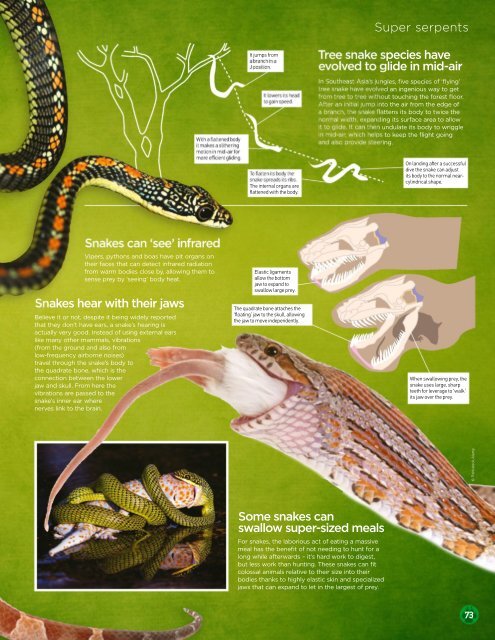World_of_Animals_Issue_46_2017
Create successful ePaper yourself
Turn your PDF publications into a flip-book with our unique Google optimized e-Paper software.
With a flattened body<br />
it makes a slithering<br />
motion in mid-air for<br />
more efficient gliding.<br />
It jumps from<br />
a branch in a<br />
J position.<br />
It lowers its head<br />
to gain speed.<br />
To flatten its body the<br />
snake spreads its ribs.<br />
The internal organs are<br />
flattened with the body.<br />
Super serpents<br />
Tree snake species have<br />
evolved to glide in mid-air<br />
In Southeast Asia’s jungles, five species <strong>of</strong> ‘flying’<br />
tree snake have evolved an ingenious way to get<br />
from tree to tree without touching the forest floor.<br />
After an initial jump into the air from the edge <strong>of</strong><br />
a branch, the snake flattens its body to twice the<br />
normal width, expanding its surface area to allow<br />
it to glide. It can then undulate its body to wriggle<br />
in mid-air, which helps to keep the flight going<br />
and also provide steering.<br />
On landing after a successful<br />
dive the snake can adjust<br />
its body to the normal nearcylindrical<br />
shape.<br />
Snakes can ‘see’ infrared<br />
Vipers, pythons and boas have pit organs on<br />
their faces that can detect infrared radiation<br />
from warm bodies close by, allowing them to<br />
sense prey by ‘seeing’ body heat.<br />
Snakes hear with their jaws<br />
Believe it or not, despite it being widely reported<br />
that they don’t have ears, a snake’s hearing is<br />
actually very good. Instead <strong>of</strong> using external ears<br />
like many other mammals, vibrations<br />
(from the ground and also from<br />
low-frequency airborne noises)<br />
travel through the snake’s body to<br />
the quadrate bone, which is the<br />
connection between the lower<br />
jaw and skull. From here the<br />
vibrations are passed to the<br />
snake’s inner ear where<br />
nerves link to the brain.<br />
Elastic ligaments<br />
allow the bottom<br />
jaw to expand to<br />
swallow large prey.<br />
The quadrate bone attaches the<br />
‘floating’ jaw to the skull, allowing<br />
the jaw to move independently.<br />
When swallowing prey, the<br />
snake uses large, sharp<br />
teeth for leverage to ‘walk’<br />
its jaw over the prey.<br />
© Thinkstock; Alamy<br />
Some snakes can<br />
swallow super-sized meals<br />
For snakes, the laborious act <strong>of</strong> eating a massive<br />
meal has the benefit <strong>of</strong> not needing to hunt for a<br />
long while afterwards – it’s hard work to digest,<br />
but less work than hunting. These snakes can fit<br />
colossal animals relative to their size into their<br />
bodies thanks to highly elastic skin and specialized<br />
jaws that can expand to let in the largest <strong>of</strong> prey.<br />
73


















